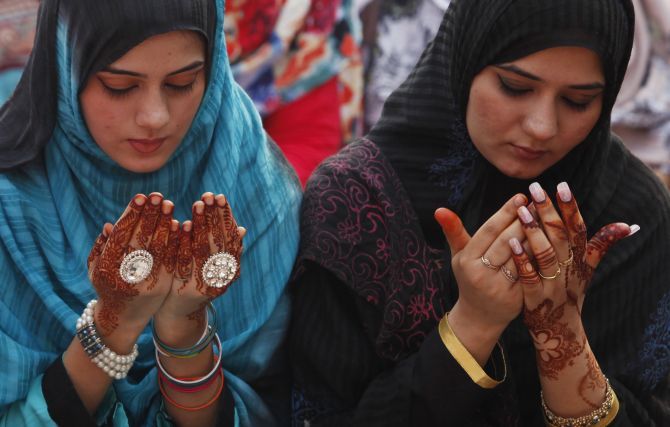'The osmosis between Hinduism and Islam that really gave birth to the Hindustani or Indo-Islamic civilisation was due to the conversation between Muslim mystics and yogis.'

Photograph: Mohsin Raza/Reuters
Do you know why no Mughal emperor ever went on the Haj and Indian Muslims started doing it only in the second half of the 19th century?
Not only Mughal emperors, many Sufi saints across the subcontinent also never went on the Haj.
Political scientist Christophe Jaffrelot reveals many such interesting facts in his new book, The Islamic Connection South Asia and Gulf.
Jaffrelot -- senior research fellow at the Centre de Recherches Internationales-Sciences Po in Paris -- is one of the foremost commentators on politics in the sub-continent.
"Akbar the Great wanted to know about all spiritual schools of thought and created a new Indian religion on that basis," Jaffrelot tells Rediff.com's Syed Firdaus Ashraf in an e-mail interview.
None of the Sufis went on the Haj nor did any Mughal emperor. In fact, many Indian Muslims believed in Ziyarat rather than going on the Haj.
How did that culture seep in Indian Muslims where they started giving more importance to local Indian Sufi shrines vis-à-vis Mecca and Medina?
I do not think that this culture had to 'seep in Indian Muslims'. It was a culture that predated the Mughals.
India was Islamised by Sufi saints to a large extent -- except Sindh where Arab invaders played an important part.
These Sufi saints did not primarily come from what is today Saudi Arabia, but from what is today Iran, Iraq and Central Asia.
The standard practice was to visit the place where they lived and were buried -- hence the pilgrimage routes going to the Dargah Sharif in Ajmer or Nizamuddin in Delhi.
Muslims in medieval India distanced themselves from the holy cities of Arabia and developed sacred sites across India. Do you think this led to more of the Ganga-Jamuni tehzeeb(composite culture)?
It was one of the factors that contributed to the Ganga-Jamuni tehzeeb because Hindus also visited these dargahs.
They paid respect to the Sufi saints and tied the mannat (threads to make a wish) like others (including Sikhs and Christians).
But the osmosis between Hinduism and Islam that really gave birth to the Hindustani or Indo-Islamic civilisation was also due to the conversation between Muslim mystics and yogis.
These exchanges probably reached their culminating point under Akbar the Great, who wanted to know about all spiritual schools of thought and created a new Indian religion on that basis.
Why there was so much of the Persian influence on the Mughals and other Indian kings?
What is today Iran has been the birthplace of many Sufi saints, including (Khwaja) Moiduddin Chisti. It was also the place where the emperor Humayun found refuge before returning to India.
The Great Mughals appreciated the civilisation of this other empire that had been built by the Safavids. They adopted Persian at their language and were impressed by the art of miniatures, the music etc.
While reading about the Khilafat movement in your book, one gets the feeling that Indian Muslims were more concerned about the Khilafat and their wellbeing rather than improving their own economic condition.
Why do foreign lands appeal to Indian Muslims rather than their own soil?
There is some misunderstanding here. Certainly, Indian Muslims (were) mobilised for defending the Khilafat.
In fact, they had started to pay more attention to West Asian Islamic sites and institutions after 1857 when the disparition of the Great Mughals deprived them of a reference point that played the role of the Khalifat till then.
They started to visit Mecca for Haj for this reason too, and not only because the means of communication had made Haj easier.
Indian Muslims supported West Asian Muslims any time they were facing some challenge before the Khilafat movement.
But this movement has been wrongly interpreted as a sign of the Muslims' allegiance to a non-Indian power centre, as if they were 'anti-national', to use a modern terminology.
In fact, those who defended the Khilafat used this sacred cause as a tool for unifying the Muslims of India who were divided at that time -- it was instrumental and not based on shared beliefs.
In fact, the Ulama who created the Jamiat-ul-Ulama-e-Hind in 1919 resigned themselves to the abolition of the Khilafat rather quickly and had no sympathy for the Wahhabis who took over Mecca soon after.
Maulana (Abul Kalam) Azad explained that the Indian Ulama could play the role of the Khalifat, which is typical of the old deshi tradition of Indian Muslims!
Arab countries fund madrassas in countries like Pakistan. Don't you feel the local people feel that this is destroying their country?
It depends what you mean by 'the local people'. Those who have no access to any other kind of education have hardly any choice -- and madrassas attract mostly poor students.
Those who have gone to the Gulf countries, including the United Arab Emirates and Saudi Arabia may be under the influence of the brand of Islam they have been exposed to there.
Fundamentalist groups like the Jama'at-e-Islami have received support (including money) from these countries and have gained momentum in such a way that they could tell the world that Wahhabism was a better form of Islam.
And that became the standard attitude after (the late Pakistani military dictator General ) Zia (-ul Haq) took over power and became a partner of Saudi Arabia against Iran, the crucible of Shi'ism.
From the 1980s onward, the rise of salafism was reinforced by sectarianism.
Maulana Usmani said in 1946 that Pakistan would pave the way for the triumphal return of Islam as the ruling power over the entire subcontinent.
Do you feel the jihadis who operate in Pakistan believe in this theory even today?
'To liberate Indian Muslims from Hindu domination' is definitely on the agenda of jihadi groups like Lashkar-e-Tayiba.
In fact, these group are less interested in global jihad than in the regional fight against the Indian neighbour.
Once again, we see how rooted in the subcontinent Islamic forces are!
Two countries were formed on the basis of religion in the 1940s -- Israel and Pakistan. How did Israel become a successful democracy and a military might, whereas Pakistan failed on all fronts?
I would not describe Israel as a successful democracy. Certainly, some democratic institutions -- including the judiciary and the media -- are rather vibrant, but Israel is an ethnic democracy where non-Jews are second class citizens.
Pakistan has experienced phases of democratisation that are worth paying attention to: None of the three military dictators could resist the demands of democratisation and (the ousted Pakistani military dictator General Pervez) Musharraf had to leave because of street demonstrations and parliamentarian activism.
The military might of Israel has much to do with a remarkable research apparatus, but also with massive investments to which the United States has contributed.
And I would not underestimate the military might of Pakistan that the country has also achieved thanks to domestic resources and external support from China, Saudi Arabia and the US again!










